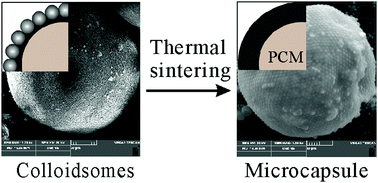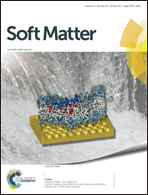Microencapsulation through thermally sintering Pickering emulsion-based colloidosomes
Abstract
Microcapsules of a phase change material synthesized by thermally sintering Pickering emulsion-based colloidosomes were demonstrated. The protocol included three steps: (1) monodispersive poly(glycidyl methacrylate) (PGMA) microspheres were prepared by dispersive polymerization and were endowed with a contact angle of 63.4° for oil-in-water Pickering stabilization by hydrolysis. (2) By phase separation during Pickering emulsion polymerization, microcapsules with a structure of a single PCM core and a PGMA armored polystyrene shell were fabricated. (3) Thermal sintering was performed to fuse the polystyrene and PGMA microspheres into an integral shell of the microcapsules. The durability of the microcapsules before and after sintering was investigated by a suspension test (in water and ethanol) and an accelerated thermal cycling test. The sintering reduced the percentage of leaked dodecanol from 19.6% to 10.3% in the suspension test in ethanol and from 10.4% to 2.8% in the accelerated cycling test. These results verified that the sintering process endowed the prepared microcapsules with better tightness and durability.



 Please wait while we load your content...
Please wait while we load your content...